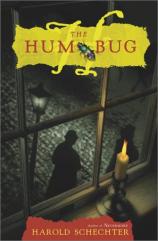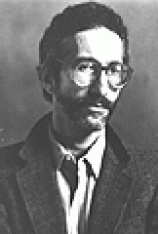Interview: January 4, 2002
January 4, 2002
With his debut novel, NEVERMORE, Harold Schechter created a most unlikely crime-solving duo when he teamed gothic master Edgar Allan Poe with "king of the wild frontier" Davy Crockett. In THE HUM BUG we again meet Poe, but this time he's paried with circusman P.T. Barnum --- as entertainingly ill-suited for the dark and drunken Poe as Crockett. Join Bookreporter.com writer Kate Ayers' discussion with Schechter to learn more about the conception of these odd couples, Poe's tendency toward excessive verbal flourishes, Caleb Carr and more.
TBR: The HUM BUG is your second book involving Edgar Allan Poe (the first being NEVERMORE), this time teaming up with P.T. Barnum to solve a series of horrific murders in New York City. How did you choose P.T. Barnum as the historical figure to be Poe's unlikely partner in crime solving?
HS: To explain why I chose Barnum, I have to go back to my first novel, NEVERMORE, and explain why I chose Davy Crockett as Poe's partner in that book. I originally conceived of NEVERMORE as a film script --- a historical action/adventure/thriller/comedy buddy-movie featuring real-life characters of larger-than-life, mythic proportions. Crockett came immediately to mind as a perfect foil for Poe. After I came up with the idea, I decided to write it as a novel in Poe's voice, and the result was NEVERMORE. When I decided to do a sequel, I had to come up with another character that fit the same bill as Crockett --- a very colorful, larger-than-life American figure who was a contemporary of Poe's; who could have plausibly crossed paths with Poe at some point; and whose personality contrasted in every imaginable way with Poe's. Barnum was an obvious choice.
TBR: From what I know of Barnum, your re-creation of him in THE HUM BUG is ostensibly true to his nature. How much research was involved in keeping his character intact?
HS: I did a great deal of research into Barnum's life. I read every biography I could get my hands on (including Saxon's P.T. BARNUM: The Legend and the Man, Adams' E PLURIBUS BARNUM, Harris' HUMBUG, and the Kunhardts' P.T. BARNUM). I also read Barnum's own autobiography and his book on the history of humbugs. My conception of Barnum's personality, however, was also shaped very much by the irrepressibly scheming character Eschol Sellers in Mark Twain's novel, THE GILDED AGE.
TBR: Since the star of the story, Edgar Allan Poe, is also a historical figure, perfecting your portrayal of his style must have taken some study too. While writing a "Poe" book, do you find yourself speaking and thinking in sentences that he might have constructed?
HS: Since I'm a professor of American literature, who specializes in the 19th century Romantics, I've been immersed in that prose style for many years. But in order to write my books, I have to do a kind of warm-up exercise each morning. Before beginning to write, I select some story of Poe's and read it until I start to hear his voice in my head.
TBR: Several times during my reading of THE HUM BUG, I got the sense you were having fun composing sentences using as many words as possible to convey an otherwise uncomplicated thought. Is this true, and how often did you do this rather than present simply a serious rendering of Poe's style?
HS: There's definitely a comical element to my writing. But writing like Poe isn't just a matter of using big words or elaborate constructions. It's a matter of capturing his diction which, in all modesty, I think I do pretty well. In fact, throughout my books (more so in NEVERMORE) I often interpolate verbatim passages from Poe and, so far, only a few hard-core Poe fanatics have been able to identify them --- i.e., differentiate them from my own writing. The thing that many people don't realize is that Poe's style is often wildly verbose and Byzantine. Here, chosen more at less at random, is a sentence from "The Fall of the House of Usher": "I was aware, however, that his very ancient family had been noted, time out of mind, for a peculiar sensibility of temperament, displaying itself, through long ages, in many works of exalted art, and manifested, of late, in repeated deeds of munificent yet unobtrusive charity, as well as in a passionate devotion to the intricacies, perhaps even more than to the orthodox and easily recognizable beauties, of musical science." It actually drives me a little crazy when reviewers criticize the style of my books as being excessively wordy or overwrought. In fact, I make a conscious effort to write a simplified version of Poe's style.
TBR: Switching between personalities in the dialogue must have been a challenge, albeit an amusing one, particularly with two such distinct personas. How did you do it so successfully?
HS: It's not so much a question of switching personalities as switching voices. Or rather, I find --- very interestingly --- that the voice creates the personality. But it can be a strain. Basically, I would use the method described above to get into my Poe voice. Then when I had Barnum speak, I'd read some of Twain's THE GILDED AGE until I got the Barnum voice going. Then I'd switch back to Poe.
TBR: Your descriptions have been likened to those of Caleb Carr. Has his work influenced you at all, and how so?
HS: Actually Caleb Carr has been influenced by my work. In fact, he very graciously acknowledges his debt to my book DERANGED at the end of THE ALIENIST. I'm happy to cash in on any association to THE ALIENIST phenomenon, but the fact is that I never conceived of my book as being in that mode. The conscious model for NEVERMORE (and by extension, THE HUM BUG) was Nicholas Meyers' THE SEVEN PERCENT SOLUTION. I was going for that tone of comic mystery-entertainment, not Carr's far more somber approach.
TBR: Much of your previous writing, that which you are most renowned for, concerns true crime. What brought you into the fiction arena?
HS: Way back in my college days, I conceived of myself as a fiction writer. I got sidetracked going for my Ph.D. in American literature but always hoped to get back to fiction. THE HUM BUG is actually my fourth novel. I wrote a couple of horror novels, one under a pseudonym, back in the mid 1990s. I was also briefly involved in doing film/TV writing and cowrote a couple of scripts for primetime TV shows (one for "The Cosby Mysteries," one for "Law and Order"). It was while working on the latter that I had the brainstorm for NEVERMORE, which, as I've already mentioned, I originally thought of as a movie script.
TBR: Did you use any of the real-life criminals you researched for your nonfiction discourses to forge your villain in THE HUM BUG or your first Poe feature, NEVERMORE?
HS: The murder of "Ellen Jennings" in THE HUM BUG was based on the famous case of the murdered prostitute Helen Jewett. But mostly the crimes in the books are strictly the product of my own lurid imagination.
TBR: Hopefully, you have plans for more historical fiction. Can you share with us what we might expect to see from you in the near future?
HS: The Poe novels seem to be turning into a series. I'm currently about two-thirds of the way through the third one, THE MASK OF RED DEATH, in which Poe teams up with Kit Carson, and I have plans for a fourth, in which Poe travels to Boston and gets embroiled in a mystery involving, among other figures, Henry David Thoreau.
TBR: As a professor of American literature and culture at Queens College, you must be very busy. How do you fit novel writing into your schedule?
HS: Well, being a professor allows a person a fair amount of flexibility, since it's not a nine-to-five, seven-day-a-week job. And I'm kind of a slow-but-steady writer. Basically, I write every morning and try to produce a minimum of one finished page a day, which is a pretty achievable goal. I keep telling students who want to write that if they just do a page a day, they'll end up with a 350 page book at the end of a year, which is essentially what I do.
TBR: Which authors and/or books have most inspired you?
HS: There are probably too many to list, but I could happily read MOBY DICK more or less endlessly. And I count Emerson among my major inspirations.
TBR: Although the answer seems obvious, can you envision THE HUM BUG as a movie? And who would you cast as P.T. Barnum and Edgar Allan Poe?
HS: God willing. I always thought Johnny Depp would make a great Poe, but he's played the part so often now --- first in SLEEPY HOLLOW, more recently in FROM HELL --- that it would seem redundant for him, so I'm not sure. Barnum's trickier. Maybe a slightly more rotund Michael Keaton. His turn in BEETLEJUICE, after all, was a kind of hopped-up, scuzzier, Barnum-type character.
TBR: Historical fiction is very popular right now. What advice can you give those desiring to break into this genre?
HS: One thing that readers seem to enjoy in my books --- particularly THE HUM BUG --- is the evocation of the period. So obviously immersing yourself in research is very important. (Actually, that's one of the reasons I enjoy writing historical fiction myself. As an academic I love to dig around in dusty old books, etc., and writing books like THE HUM BUG allows me to gratify that interest.)




